Jerusalem Report logo small (credit: JPOST STAFF)
Pretend for a moment that the
Vatican has in its possession some sacred and precious relics that were originally in the Herodian Jewish Temple located in Jerusalem 1,950 years ago.
If you were the pope living in the 14th century and could verify this fact, would you not ask yourself how indeed such Jewish artifacts had come to your residence in the first place?
Top Articles By JPost
After some digging around (no pun intended), you would have found that your new Vatican residence was actually built over sections of Caesar’s Palace – the Vatican, including St. Peter’s Basilica, was constructed over Emperor Vespasian’s Roman palace approximately 200 years after the sacking of Rome in 455 AD. Indeed, there are excavations going on there right now, even as you read this magazine.
What this means is that the vandals and the Visigoths passed over, or simply didn’t find, the select treasures secreted away in that palace, and instead took with them the many items on public display in the Temple, located not far away.
It says in the Talmud that the famous Jewish sage and author of the Zohar,
Rabbi Shimon bar Yochai, went to Rome with his colleagues to nullify harsh decrees placed on Judea, and while there, saw the exact items mentioned in this article. They ended up being royal guests at Vespasian’s palace after being asked to attend to his ailing daughter. When they miraculously did heal her, the sages were afforded the chance to see these extremely holy items, proving that they were kept in that place.
The spiral stairs of the Vatican Museums, designed by Giuseppe Momo in 1932. (credit: Wikimedia Commons)
In fact, historian Josephus Flavius records the event in which Vespasian took for himself these items specifically as his special treasures for safekeeping, including an ancient Torah scroll.
According to Vatican expert Dr. Michael A. Calvo, those vessels and others found their way to the Vatican via another route, after making their way to Byzantium: “These include Temple candelabra given to Pope Innocent III by Baldwin I after the sacking of Constantinople and the massacre of the Christian Orthodox population,” Calvo claims. “Temple shofars and utensils; garments of the High Priest; the Tzitz – a gold plaque with the words Kodesh L’Hashem (“Holy to the Lord”); cultural objects, and many other objets d’art, books and manuscripts that the Vatican and other churches have appropriated and placed in their own storerooms, libraries and museums.”
But where is the factual, tangible proof that the Vatican “inherited” these sacred items and retains them until today?
The Israeli Foreign Affairs Ministry and security services may already have evidence: about 50 years ago, there was a certain Jewish student – let’s call him DM – who was enrolled in a correspondence course at the Urbaniana, the Vatican’s university. Upon attending in person for the last semesters of his doctorate, he found himself the only Jew among 17,000 students! DM told me that he was well-loved, but when push came to shove, both professor and student approached him respectfully in order to convert him.
After firmly refusing time after time, a friend of his (later to become one of the Vatican archivists, Cardinal Antonio Samore) offered to show him what “used to be” his Jewish heritage – the Temple vessels – in an attempt to entice him to convert. DM agreed to be taken to see them months later, at night. When I asked him if there was anything in that cave that had belonged to the Temple, he simply replied: “Everything is there!”
Did he really see anything, or just come close? Many years later, in 2002, DM apparently gave sufficient proof to then-foreign minister Shimon Peres and others who were in negotiation with high-level Vatican officials at the time. If this is true, Israel may already have a solid, well-documented case.
So now what? Today in the 21st century there is a thriving sovereign State of Israel, being the sole worldwide representative of the Jewish people, or the World Jewish Congress, both being adequate addresses to make an arrangement for some sort of repatriation deal.
In the meantime, Roman Catholic relations with Israel are on the rise, dialogue and cooperation with the Jewish state are close, and there are even several Jews who have been knighted by recent popes. So why not negotiate over whatever there is now?

